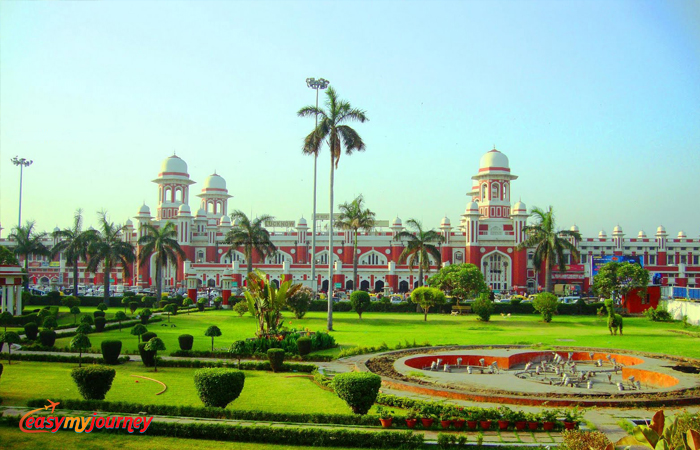The heritage city of Lucknow in India was the old capital of the nawabs of Awadh where culture, courtesy and courtly lifestyle reigned supreme. Life in Lucknow was characterised by an old world charm with warmth, hospitality and a genteel formality inherent in every facet of its people. The city saw its most glorious days under the Nawabs when it became a great centre for literature, music, dance, arts and crafts. Contemporary Lucknow is a far cry from the elegance and class of the old Awadh; now, the city is very much a reflection of modern India with unplanned development, crowded streets and polluted air. But the discerning traveller can still glimpse of the aura of those heady days in the heritage sites, old monuments, ruins and inner city lanes and alleyways.
How to Reach Lucknow?
By Air : The Amausi airport in Lucknow gets flights from Delhi, Patna, Varanasi, Calcutta and Mumbai. From the airport you can take a taxi to the centre of town.
By Rail : Lucknow is a major junction of the Northern Railways, and well connected with all major cities in the country. The Charbagh Railway Station has a computerised reservation counter. It is about 4 kms from Hazratganj. The City Railway station is in the Husainabad area, near most historical sites.
By Road : Most buses terminate at the Charbagh Bus stand near the railway station. They include local services as well as services from Varanasi, Allahabad, Lucknow, Jhansi and Kanpur. Other long-distance buses stop at the Kaisarbagh bus stand near the city centre.
Best Time to Visit Lucknow
The best time to visit Lucknow is from October to March, when the climate is pleasant and ideal for sightseeing and other outdoor activities. Lucknow has subtropical climate. The summer months are warm, whereas the winter months are cold and dry.
During the summer season, from March to June, it is extremely hot, with the level of mercury reaching a maximum of 45°C, so avoid visiting Lucknow during summer months. Monsoon season stretches from July to September and it is not ideal for sightseeing.
Things to do in Lucknow
Lucknow being a city with a lineage has plenty of things to do for the person interested in history. View the architecturally important Imambara and the imposing Rumi Darwza. Take a trip back into the days of the BritishRaj when you drive through the British Residency and the Kaiserbagh area – Lucknow is full of reminders of the British days. Don’t miss the Chota Imambara – this is structure looks particularly pretty when it is lit up during festivals.
Go on a gastronomic tour in Hazratganj, the central hub of Lucknow. Sample the absolutely melt-in-the- mouth Awadhi kebabs and the delicious biryanis that Lucknow is so well known for. Shop for the Lucknowi kurta before you go home. Lucknow is an interesting city with history and culture written on every stone!
Places Near Lucknow
The places near Lucknow are the Kukrail Reserve Forest and the Nawabganj Bird Sanctuary. The Kukrail forest, developed by the Forest Department, has a deer park and a crocodile nursery. Nawabganj bird sanctuary attracts migratory birds from central Asia during winter.
The tomb of Syed Haji Waris Ali Shah, known as Deva Sharif is 25 kms away from Lucknow. The saint is revered by both Hindus and Muslims,and the annual Urs in October–November is a good time to visit the tomb.
Naimisharanya – Misrikh, a temple complex dedicated to several Hindu gods and goddesses is 94 kms from Lucknow.
Bareilly, northwest of Lucknow, was founded by the Barel Deo brothers in 1537. It was handed over to the British in 1801. There are 17th century mosques and two churches in the town. Bareilly is known for its iron industry and zari (embroidery in gold thread) work. It is connected both by road as well as rail. Being an important railway junction, trains from major cities like Dehra Dun, Delhi and Varanasi stop here. Most of the accommodation is on the Station Road.
Faizabad was the capital of the Avadh rulers, till it was shifted to Lucknow by Nawab Asaf-ud-Daula. Nawab Shuja-ud-Daula built the Fort Calcutta here in 1764. Another interesting building is the tomb of Bahu Begum, the widow of Nawab Shuja-ud-daula. The 42-metre high structure is built in white marble tomb. Faizabad is 124 kms from Lucknow, and has good road as well as rail connections. Modest accommodation is available, with some hotels offering air-conditioned rooms.
Hotels in Lucknow – Choice is Yours
There are numerous hotels in Lucknow ranging from 3-star, 4-star and 5-star deluxe to budget hotels.

